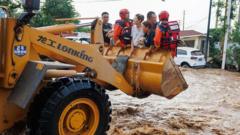At least 30 people have been confirmed dead in Beijing, with more than 80,000 individuals evacuated as torrential rains cause widespread flooding in northern China, according to local authorities. The flooding has not only submerged roads but also left many residents isolated and in dire need of rescue.
The severe weather pattern has extended beyond the capital; an additional eight casualties were reported from a landslide in Chengde city, located approximately three hours northeast of Beijing. This summer has seen China grappling with unprecedented weather events, including record heatwaves in the east and consistent flooding in the southwest.
In light of the devastation, President Xi Jinping has called for comprehensive rescue operations, emphasizing the need to brace for the "worst-case and extreme scenarios." He instructed relevant agencies to leave no stone unturned in their search for individuals who are missing, and to prioritize the safety and resettlement of displaced residents. To support recovery efforts, the Chinese government has promised 200 million yuan (around $28 million) aimed at restoring damaged infrastructure and services.
The areas around Beijing, particularly the suburban districts of Miyun and Huairou, were severely impacted by the downpour, leading to substantial damage to transport routes and power outages affecting over 130 communities. Eyewitness accounts describe a rapid onset of the disaster, with residents recalling how quickly floodwaters consumed their locality.
One resident, Ms. Yang from Hebei province, voiced her concerns for her family in a flood-affected region, struggling to communicate with them as they face health hardships and limited mobility. In a bid to secure their safety, she reached out on social media, hoping for rescue.
Other residents echoed similar sentiments, reminiscing about the sudden rise of water levels. Local businesses and homes were quickly inundated, eliciting accounts of anxious waits for external assistance as the threat of flooding became reality.
Historically, Beijing experiences flooding during this season, with a particularly deadly incident occurring in July 2012, when intense rainfall led to 79 fatalities. This summer’s torrential rains are not isolated, as previously this month, Typhoon Wipha in Shandong resulted in two deaths and ten individuals missing. Additionally, landslides across regions have also claimed lives in recent weeks.
Though natural disasters continue to disrupt daily life and the economy in China, experts associate these extreme weather conditions with climate change, raising concerns over the impact on the world's largest agricultural sector. The Ministry of Emergency Management indicated that in the first half of the year, disasters have cost the country approximately 54.11 billion yuan ($7.5 billion), with flooding constituting over 90% of those losses.




















